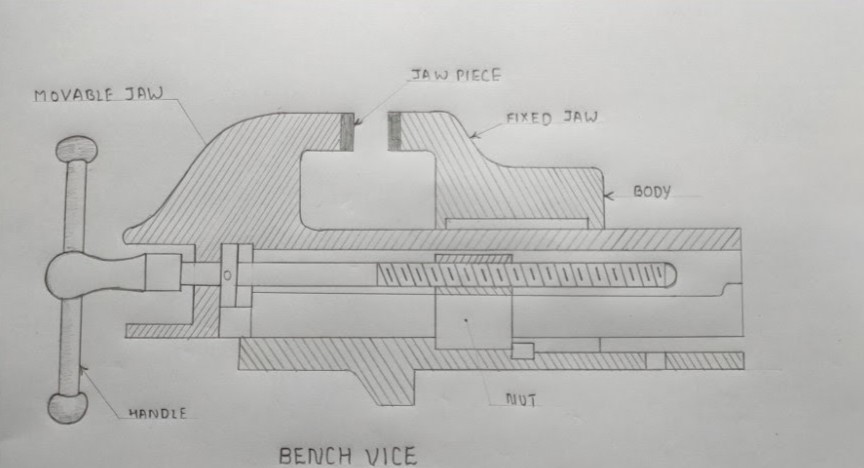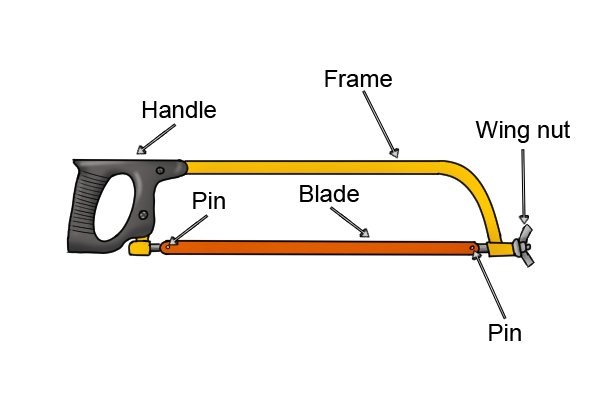Q1. What does mean by Bench Work and Fitting?
Ans: Bench work refers to a set of activities that involve working on a workbench or table to assemble, disassemble, or repair mechanical components or equipment. This can include tasks such as cutting, shaping, drilling, sanding, and polishing various materials such as metal, wood, and plastics using hand tools such as saws, files, chisels, and hammers.
Fitting, on the other hand, is a process of joining two or more parts together to create a functional assembly. This involves the use of precision tools such as micrometers, vernier calipers, gauges, and screwdrivers to ensure that the parts fit together correctly and operate smoothly. Fitting is an important part of mechanical engineering and is used in a wide range of applications, from manufacturing to maintenance and repair.
Q2. State the different processes done in fitting shop.
Ans: Sawing: This involves the use of hand or power saws to cut the workpiece into the required shape or size.
Filing: This involves the use of files to remove excess material and to achieve the desired shape and finish.
Drilling: This involves the use of drilling machines or hand-held drills to create holes in the workpiece.
Tapping: This involves the use of tapping tools and taps to create internal threads in the workpiece.
Grinding: This involves the use of grinding machines to remove material and achieve a precise shape and finish.
Assembly: This involves the use of bolts, nuts, screws, and other fasteners to join different parts together.
Welding: This involves the use of welding machines to join metal parts together by melting and fusing them.
These processes may be used individually or in combination, depending on the requirements of the job.
Q3. List the various types of tools used in fitting shop.
Ans: Fitting shops are workshops where metal components are fabricated and assembled to create mechanical structures. The following are some of the common types of tools used in fitting shops:
Holding Tools: Holding tools used in fitting shop comprises of basically vices and clamps. The clamps are C or G clamp, plane slot, goose neck, double end finger, u-clamp, parallel jaw, and clamping block.
Measuring and marking tools: These are used to measure and mark metal components accurately. Examples include calipers, micrometers, rulers, squares, marking gauges, and spirit levels.
Cutting tools: These are used to cut metal components into the desired shape and size. Examples include hacksaws, power saws, milling machines, and lathes.
Miscellaneous Tools: Vacuum cleaner dry / wet. Wrenches. Miscellaneous,Sockets, Wallet roll, Drillbits, Pliers, Rivets,Screwdrivers.
Q4. With the help of neat sketch explain the construction and working of bench vice.
Ans:

A bench vice is a clamping device that is fixed to a workbench or a table to hold workpieces securely during various metalworking tasks. The following is a description of its construction and working:
Construction:
A typical bench vice consists of the following parts:
Jaws: The jaws are the two parallel clamping surfaces that hold the workpiece. They are usually made of hardened steel and can be replaced if they become worn or damaged.
Spindle: The spindle is a long screw that connects the two jaws. It is turned by the handle to open and close the jaws.
Handle: The handle is used to turn the spindle and open or close the jaws.
Guide rods: Guide rods keep the jaws in alignment and prevent them from twisting or tilting when pressure is applied.
Mounting bracket: The mounting bracket is the part that attaches the vice to the workbench or table.
Working:
The following is a description of how a bench vice works:
Mounting: The bench vice is mounted securely to the workbench or table using bolts or screws.
Opening: The handle is turned to rotate the spindle, which opens the jaws. The workpiece is then placed between the jaws and the handle is turned in the opposite direction to close the jaws around the workpiece.
Clamping: Once the workpiece is securely held between the jaws, pressure is applied by turning the handle clockwise. This causes the jaws to grip the workpiece tightly.
Releasing: To release the workpiece, the handle is turned counterclockwise to release the pressure on the jaws, and the spindle is rotated to open the jaws.
It provides a secure and stable platform to hold workpieces for various machining operations.
Q5. List the different types of marking and measuring tools.
Ans: The following are the different types of marking and measuring tools:
Surface plates: Used as a reference surface to check the flatness and squareness of the workpiece.
Try squares: Used to check the squareness of the workpiece.
Scribers: Used to mark lines on the workpiece.
Odd leg Caliper: This is also called ‘Jenny Caliper’ or Hermaphrodite. it has one leg pointed like a divider and the other leg bent like a caliper.
punch: punch is a tool used to indent or create a hole through a hard surface. They usually consist of a hard metal rod with a narrow tip at one end and a broad flat “butt” at the other.
calipers: Used to measure the internal and external dimensions of the workpiece accurately.
Spirit level: It is used to check the leveling of machines.
Protractors: Used to measure angles of the workpiece.
Q6. What are the different types of files? Explain each of them.
Ans: The following are the different types of files:

Flat file: The flat file has a rectangular cross-section and a flat surface with double-cut teeth on both sides. It is used to remove material quickly and flatten large surfaces.
Half-round file: The half-round file has a semi-circular cross-section with one flat surface and one curved surface. It is used to shape convex or concave surfaces, and to smooth inside curves.
Square file: The square file has a square cross-section and teeth on all four sides. It is used to file square or rectangular holes or to create straight edges and corners.
Triangular file: The triangular file has a triangular cross-section with teeth on all three sides. It is used to file angles and corners, and to sharpen tools with pointed tips.
Needle file: The needle file is a small, thin file with a pointed tip and single-cut teeth.
Rasp file: The rasp file has a rough, abrasive surface with large teeth that are used to remove material quickly from wood or other soft materials.
Diamond file: The diamond file has a diamond-coated abrasive surface that is used to file and shape hard materials, such as ceramic, glass, and stone.
Curved file: The curved file has a curved surface with teeth on one side. It is used to shape and smooth curved surfaces, such as pipes or tubing.
Q7. Sketch and describe hacksaw.
Ans: A hacksaw is a handheld cutting tool commonly used to cut through metal, plastic, and wood. It consists of a U-shaped frame with a handle on one end and a narrow blade stretched across the other. The blade is typically made of high-carbon steel and has a row of sharp teeth along one edge.

The Hack Saw is used for cutting metal by hand. It consists of a frame, which holds a thin blade, firmly in position. Hacksaw blade is specified by the number of teeth for centimeter. Hacksaw blades have a number of teeth ranging from 5 to 15 per centimeter (cm). Blades having lesser number of teeth per cm are used for cutting soft materials like aluminum, brass and bronze. Blades having larger number of teeth per centimeter are used for cutting hard materials like steel and cast Iron.
Q8.Sketch and describe Bench drilling machine.
Ans: A bench drilling machine is a power tool used for drilling precise holes in various materials. It consists of a base, a column, a worktable, a spindle, and a motor.
The base of the bench drilling machine is usually made of cast iron, providing a sturdy foundation for the entire machine. The column, which is bolted to the base, supports the spindle and worktable. The worktable can be adjusted up and down, allowing the user to drill holes at different depths.

The spindle, which is driven by the motor, holds the drill bit and rotates it at high speeds to create the hole. The spindle speed can be adjusted to match the material being drilled and the size of the drill bit.
The drill bit Is held in place by a chuck, which can be opened and closed using a key.
The user places the material to be drilled onto the worktable and positions it under the drill bit. The depth of the hole is set by adjusting the worktable height or using a depth stop.
Bench drilling machines can come in different sizes and configurations, depending on the specific needs of the user.
Some bench drilling machines have additional features, such as a laser guide for more precise drilling or a coolant system to keep the drill bit cool and reduce friction.